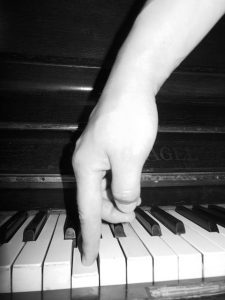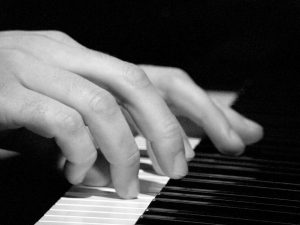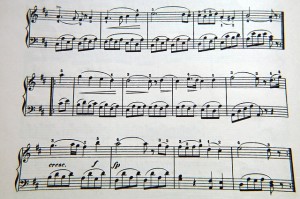 A common question I hear from my piano students is, “How important is piano fingering?” Take it from an experienced pianist, performer, and teacher: piano fingering is EXTREMELY important! Here are some of the reasons why:
A common question I hear from my piano students is, “How important is piano fingering?” Take it from an experienced pianist, performer, and teacher: piano fingering is EXTREMELY important! Here are some of the reasons why:
1. Consistency
If you use a different fingering every time you play a passage of music, then every time, your brain and fingers have to consciously make the choice of which fingering to use. This slows you down and leads to hesitations and stuttering. Consistent fingering lets you play accurately without impediment so you’re always ready for the next measure of music. If you haven’t learned the correct fingerings, you haven’t really learned the piece.
2. Movement
Over the centuries, expert musicians have fine tuned correct piano fingering. The correct fingering is designed to make your hand and fingers move in the best way to prepare you to play the current and upcoming notes and keys. The shape of your hand, the shape of the keys, and which notes come next are all relevant factors.
For example, in a one-octave ascending C Major scale (C D E F G A B C), your right hand fingering is 1-2-3-1-2-3-4-5. Tucking your thumb under after you play your 3 prepares you for the rest of the scale and puts your fingers in the perfect position to play the remaining notes. This is also the most comfortable way to play it, and it’s the best movement for the hands.
However, notice how the fingering changes when your right hand plays a one-octave ascending Eb Major scale: Eb F G Ab Bb C D Eb = 3-1-2-3-4-1-2-3. Notice how your hand shape still matters – you’re still tucking your 1 under your 3 – but since there are black keys in this scale, the order changes slightly so that the longer fingers are the ones that play the shorter black keys. It’s easier to reach them, more comfortable, and allows you to player more quickly and cleanly.
3. Speed
The correct fingering can make your fingers faster. For example, you can play repeated tones far more quickly if you switch between fingers, i.e. 3-2-1-3-2-1-3-2-1 or 3-2-1-2-3-2-1-2 on the same key vs using your 3 a bunch of times in a row. It takes practice to learn how to do so, but it’s worth it, because trying to use a single finger to play one key many times in a row will inevitably slow you down and tire out your hands and forearms.
Likewise, if you forget to use the proper fingering and don’t look at what’s coming next, you will realize too late that your hand will have to hop to reach the next key, and this will also slow you down. Or, you’ll make erroneous judgment calls like crossing your 3 over your 5, which slows you down, affects the quality of the sound, is incredibly awkward for your hands, and could eventually lead to tension, pain, or injury.
 4. Musicality
4. Musicality
Fingering is often designed to help you play a phrase in the most musical way. With the example above, if you have a single repeated note and you try to play it with the same finger over and over, you will end up with inconsistencies in your finger pressure so that the repeated tones are irregular, with some slightly louder, harder, shorter, longer, etc.
Fingering is also written so that certain fingers play specific notes so that they receive the proper emphasis. For example, if you have to play an isolated accented note, you probably won’t use your 4 finger to do so (unless you have a very good reason for doing so) because it is weaker and more difficult to control.
This is also why it is much better to use 3-2-3-2 to play a trill than 5-4-5-4, because you have more control over those fingers, the sound is more consistent, and it makes the trill sound cleaner and better.
However, bear in mind that sometimes strange fingerings are required for the sake of musicality. You may need to stretch certain fingers or do certain crossovers that seem unnatural but allow the musical phrase or melody to continue in the most uninterrupted way. If you see fingerings that seem particularly odd, consider why the composer or edited might have written those fingerings and check them with your teacher. Sometimes fingerings are odd but they’re the most correct way to play it, and other times there are multiple ways of correctly fingering a passage.
5. Protecting Your Hands
Often when I see pianists using awkward or horribly wrong fingerings, I cringe a little because not only does it affect the sound of the music, it can also lead to injury. Poor fingerings can create awkward hand tension and even cause pain or injury. Every pianist should be careful to use proper form and fingering while playing to protect their hands and avoid injury.
6. Memorization
Pianists often have to memorize their music, but memorizing the notes is only part of the memorization process. Along with the notes, dynamics, expression, tempo, etc. etc., you also need to memorize the fingering…otherwise, your fingers really DON’T have the piece memorized. If you learn the correct fingering from the beginning and use it every time, muscle memory becomes your friend, and memorizing your music becomes much easier.
Also, if you’ve learned the correct fingerings for all the scales and arpeggios, your fingers will already have the muscle memory so that when these patterns pop up in your music (as they often do), your hands automatically know what fingering to use.
7. It’s Easier!
This takes a little while to learn, but it’s true! Once you learn how to use the correct fingerings, you will realize that following the correct fingerings makes playing SO much easier. I love it when I see a student finally understand this after struggling to grasp the purpose of fingerings.
One More Point…Fingering CAN Sometimes Be Changed.
While there are certain finger patterns that should be used by virtually every pianist, sometimes fingerings have to be adapted. Not everyone’s hands are the same size, and some pianists cannot comfortably play certain passages with the recommended fingering. In cases like this, it is perfectly acceptable to change the fingering if you make sure that your new fingering is practical and still retains as much musicality for the passage as possible. I often have to do this for young students whose hands are still growing.
Many passages of music do not have written fingerings, and the performer can decide which fingerings are best. Those fingerings that are written can serve as a guide. Sometimes I change fingerings simply because I figure out something that works better for me. (You should only do this if you’ve studied piano for years or your teacher has told you it is okay for you to do so.) Any fingerings you modify or figure out for yourself, you should write into your music so that you use them every time.
 If these reasons haven’t convinced you, then I plead with you to just trust me and trust your music. If your sheet music doesn’t guide your fingering, ask a good piano teacher to help you figure out what fingering to use. There is some level of subjectivity in correct fingering, but until you are more advanced, trust what the experts before you have recommended. Over time, you will learn to appreciate the value of correct fingering, and you will be a much better pianist for it.
If these reasons haven’t convinced you, then I plead with you to just trust me and trust your music. If your sheet music doesn’t guide your fingering, ask a good piano teacher to help you figure out what fingering to use. There is some level of subjectivity in correct fingering, but until you are more advanced, trust what the experts before you have recommended. Over time, you will learn to appreciate the value of correct fingering, and you will be a much better pianist for it.

Excellent post, MusicalBri! I agree and will ask my students to read this! (or have it read or explained to them!). How is it that you can explain things SO WELL???
Thank you! I was well-taught by my former teachers, including experience and trial/error 🙂 I hope my thoughts will help you and your students! If you feel like I missed anything important, please share. I’d love to make my posts as useful as possible to the music community.